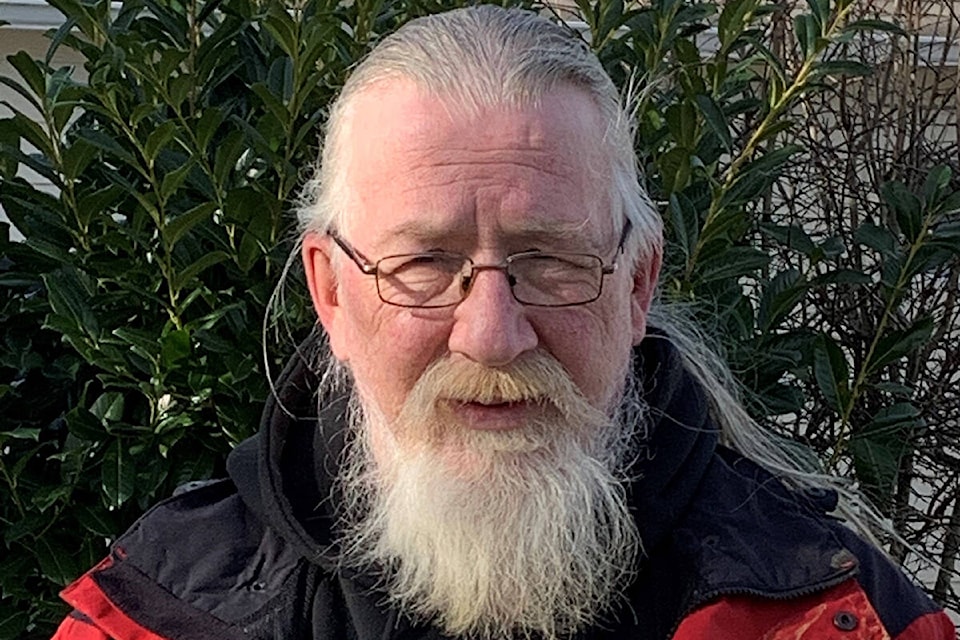Part 1 of a three-part series
By Jennifer John
Nobody wakes up in the morning and thinks, “I want to be homeless today,” but that was Kevin Nicholson’s reality for many years.
“Homelessness can happen to anybody, for any reason, at any given time,” he said. “I lived as working homeless in Kelowna and area. I think I only had a mailing address for 10 months out of eight years.”
Nicholson grew up battling mental health issues during his childhood in southern Alberta, running away from home at age 14 and having to fend for himself on the streets. For the next few decades, he spent some time working on Vancouver Island, but primarily resided in Kelowna, finding work where he could.
Five years ago, with a few hundred dollars in his pocket and dreams of living out his senior years on Vancouver Island, he travelled back to the area he had worked as a young man, only to realize housing was no longer affordable.
“The Island had changed a lot in the last 30 years, and I found myself in a tent,” he said.
This is the reality many people face with skyrocketing rental costs and occupancy rates at 0.2 per cent in Parksville and 0 per cent in Qualicum Beach.
According to an article in the Parksville Qualicum Beach News in October 2021, the average rental cost of a one-bedroom suite in B.C. costs a whopping $2,155 per month and is steadily increasing. SOS seniors advocacy services co-ordinator Dawn Barry revealed many local residents, including seniors, who are on fixed incomes such as income assistance, disability pensions, CPP, and OAS (government pensions) are only a paycheque away from homelessness. In the face of emergency costs — such as dental visits or auto bills, residents are being forced to choose between food, utilities and accommodation. In some cases, this means that they are evicted from their homes and there are few options.
“Seniors are being displaced,” she said. “There is nowhere for them to go. They have to leave the community and it is heartbreaking.”
Homeless Hub, a web-based research library and information centre, defines homelessness as “the situation of an individual, family, or community without stable, safe, permanent, appropriate housing, or the immediate prospect, means, and ability of acquiring it.”
Although many people are familiar with the traditional idea of homelessness: people who sleep on the streets — others fall into the category of hidden homelessness.
READ MORE: 23,000 people experienced homelessness in B.C. in 2019, new data shows
Raise the Roof, a Canadian homelessness prevention charity, estimates nationally, more than 80 per cent of homeless individuals fall into hidden homelessness. This includes residents who live in their cars, couch surf with friends, or live in RVs with no electricity, water, or septic.
“Life in a shopping cart, bike trailer, derelict camper, and RVs with no amenities are all consequences of no place to call home,” Nicholson said.
For those on a fixed income, the shelter portion of income assistance amounts to $375 a month per person with no children. For those on disability, who can still work part-time, the provincial minimum wage is currently $15.65. A person working full-time on minimum wage makes $2,191 a month before taxes. And some residents, who do not have the ability to work at all, have no way to increase their income levels to match housing costs.
Homeless Hub debunks the myth that homeless folks just need to dig in their heels and work a bit harder. There are many reasons individuals become homeless, and even more challenges associated with getting people off the streets once they find themselves there. According to a Point in Time (PiT) homeless count conducted in 2021 in the Parksville Qualicum Beach region, our homeless population is not people from big cities, but those who have lived here, and consider it home.
The report found that of the 87 homeless respondents, 16 per cent had always lived here, 41 per cent had lived here for more than 10 years, and 15 per cent had lived here between five and 10 years. The report also found that 44 per cent experienced homelessness for the first time as a youth, and 25 per cent had been in foster care, a youth group home or under a youth agreement.
Although Nicholson’s campsite was destroyed three times since he arrived in the area, he considers himself lucky. He was able to find support locally from the Salvation Army, Manna Homeless Society, SOS, and Forward House Community Society. He received assistance finding a family doctor and applying for his CPP and other government supports. With help from local agencies, he found accommodation in a trailer and said he finally feels “safe and at peace.”
He is now working as a Forward House outreach worker.
“I got rid of a lot of personal baggage I’ve been carrying around for 50 years,” he said. “I’m learning new skillsets and sharing my skillsets, working outside my comfort zone.”
Nicholson continues to volunteer with homeless residents and advocate for them. He also writes poetry and “enjoys the wonders of life.”
Jennifer John is the Oceanside Task Force on Homelessness co-ordinator. This article has been produced through the efforts of the Union of BC Municipalities Strengthening Communities’ Services Grant.
